Beaurty Is as Beauty Does: The Marriage of Visual Appeal and Sustainability
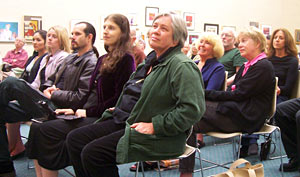 by Linda Buzzell-Saltzman by Linda Buzzell-Saltzman
June, 2005
The Sustainable Small Cities Project, For the Future
The Sustainable Small Cities project of Santa Barbara think tank For the Future recently (June 14) hosted a community discussion on whether beauty and sustainability can coexist in Santa Barbara. The well-attended event (around 70 people) held at the downtown library was co-sponsored by HopeDance magazine, The Sustainability Project, The Santa Barbara Permaculture Network, The Santa Barbara Organic Garden Club and The International Association for Ecotherapy.
Part of the impetus for holding this event was the increasing conflict between beauty and sustainability issues in Santa Barbara. The June 9 issue of The Independent featured two writers who mentioned community concerns about weeds in pesticide-free parks, the ugliness of solar panels on red-tiled roofs and potential damage to Gaviota Coast views from proposed offshore wind-energy platforms.
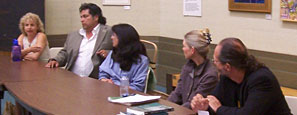 Beauty is a core community value in Santa Barbara, inspired by our exquisite natural surroundings and also embedded in the city’s history and codes. Sustainability has also become an increasingly important local community value here. Of course in Chumash times both beauty and sustainability were always a way of life here, but more recently the city has lost sight of the necessity for local independence and sustainability, in spite of the fact that Santa Barbara is the birthplace of the modern environmental movement. But now that the planet is running out of cheap fossil fuels and is facing accelerating climate disruption, sustainability is an urgent necessity. As the Community Environmental Council slogan puts it, Santa Barbara must become “fossil free” as soon as possible. Beauty is a core community value in Santa Barbara, inspired by our exquisite natural surroundings and also embedded in the city’s history and codes. Sustainability has also become an increasingly important local community value here. Of course in Chumash times both beauty and sustainability were always a way of life here, but more recently the city has lost sight of the necessity for local independence and sustainability, in spite of the fact that Santa Barbara is the birthplace of the modern environmental movement. But now that the planet is running out of cheap fossil fuels and is facing accelerating climate disruption, sustainability is an urgent necessity. As the Community Environmental Council slogan puts it, Santa Barbara must become “fossil free” as soon as possible.
But are these two values of Beauty and Sustainability compatible? Is it EITHER/OR or can we have both?
One thing is clear: superficial "prettiness" is no longer enough. For Santa Barbara to be a truly viable city in the future, beauty must find a way to combine with sustainability. True beauty isn’t just skin deep -- a lovely surface covering a multitude of dark secrets -- but must also be deeply healthy for people and our environment. Beauty is not only an aesthetic value, but a quality of daily experience that we need just as we need clean air and water.
… a gorgeous red rose dripping with toxic pesticides doesn’t smell as sweet…
… a bright green, highly manicured lawn soaked in imported water and drenched in toxics that flow into our creeks and the ocean isn't really beautiful...
… an exquisitely arranged plate of artistically-presented food full of chemicals isn't beautiful...
… hairdos, manicures, face lifts or silicone breasts aren't beautiful if they harm the client or the professional who works on her...
… vinyl kitchen flooring, outgassing rugs made from petroleum, furniture and bedding drenched with formaldehyde aren’t beautiful, no matter how trendy they may look…
… a mansionized architectural masterpiece isn't beautiful if it uses unsustainable woods, poisons the house's inhabitants or workmen, covers over every inch of plantable land on the property, becomes an energy-hog or sends a tear-down to the landfill...
… a shiny, bright red apple sprayed with pesticides and waxed with petroleum-based paraffin isn’t appealing…
The speakers addressed a number of important questions: Do we need to re-educate our eyes to appreciate natural beauty? Do sustainability folks need to learn aesthetics? How can Santa Barbara become a truly, deep-down beautiful city that is also sustainable?
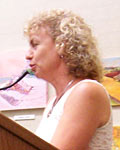 The five speakers who addressed these issues included Ojai evolutionary psychologist Dr. Peggy La Cerra, who helped the audience understand the difference between true beauty and pseudo-beauty. The brain perceives health and fertility as attractive. Unfortunately human beings have learned how to fake those qualities, and this artificial industrial version of beauty is destroying our health and the planet. The five speakers who addressed these issues included Ojai evolutionary psychologist Dr. Peggy La Cerra, who helped the audience understand the difference between true beauty and pseudo-beauty. The brain perceives health and fertility as attractive. Unfortunately human beings have learned how to fake those qualities, and this artificial industrial version of beauty is destroying our health and the planet.
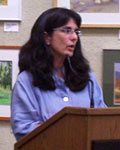 LivinGreen’s Ellen Strickland stressed the importance of place-based design. She pointed out that designers and architects must let go of imposing their own favorite visions on a particular place, but rather listen to what the place tells us is appropriate. French chateaus or glass-and-steel modernist mansions aren’t really appropriate for Santa Barbara. Strickland, who has two stores featuring “green” materials for interiors (www.livingreen.com), also showed us many examples of beautiful, sustainable products for the home – rugs, tiles, fabrics, wall-coverings and more. LivinGreen’s Ellen Strickland stressed the importance of place-based design. She pointed out that designers and architects must let go of imposing their own favorite visions on a particular place, but rather listen to what the place tells us is appropriate. French chateaus or glass-and-steel modernist mansions aren’t really appropriate for Santa Barbara. Strickland, who has two stores featuring “green” materials for interiors (www.livingreen.com), also showed us many examples of beautiful, sustainable products for the home – rugs, tiles, fabrics, wall-coverings and more.
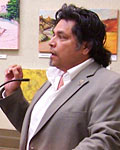 Permaculture designer Larry Santoyo explained natural ecological design. He stressed the beauty of function and the function of beauty. He takes his inspiration from nature and natural processes, especially sequential patterns, the flow and ebb and flow of life. He helped the audience think about the humble grasses, and how they are so brilliantly designed to withstand the chomping of large, grazing animals. They, in turn, are succeeded by the thistles, which repel the herds and allow the grasses to regrow and recover. He helped us understand natural species and ecosystems working in synergy – a process, not a fixed end product. Permaculture designer Larry Santoyo explained natural ecological design. He stressed the beauty of function and the function of beauty. He takes his inspiration from nature and natural processes, especially sequential patterns, the flow and ebb and flow of life. He helped the audience think about the humble grasses, and how they are so brilliantly designed to withstand the chomping of large, grazing animals. They, in turn, are succeeded by the thistles, which repel the herds and allow the grasses to regrow and recover. He helped us understand natural species and ecosystems working in synergy – a process, not a fixed end product.
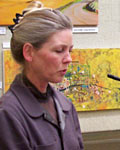 Designer of landscapes and architecture Carlene Ramus, who was trained in architecture in France and worked with Cradle to Cradle architect Bill McDonough, gave some wonderful examples of sustainable architecture and landscaping from her own practice. She emphasized the importance of “small house, big land” design instead of “big house, no land” (mansionization). She has used creative sustainable solutions like recycled blue jean insulation, sod/grass roofs and readily available on-site materials. She mentioned using grass block pavers instead of driveways, and filling the spaces with yarrow and native grasses. She describes her approach as The New Beauty – a joy-beauty, full of visual delight as well as highly sustainable and healthy. Designer of landscapes and architecture Carlene Ramus, who was trained in architecture in France and worked with Cradle to Cradle architect Bill McDonough, gave some wonderful examples of sustainable architecture and landscaping from her own practice. She emphasized the importance of “small house, big land” design instead of “big house, no land” (mansionization). She has used creative sustainable solutions like recycled blue jean insulation, sod/grass roofs and readily available on-site materials. She mentioned using grass block pavers instead of driveways, and filling the spaces with yarrow and native grasses. She describes her approach as The New Beauty – a joy-beauty, full of visual delight as well as highly sustainable and healthy.
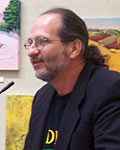 Landscape architect Owen Dell issued a ringing denunciation of traditional “beauty professionals” who are paid big bucks to destroy landscapes by imitating the nature they destroyed in the first place. He decried the hypocrisy of many designers who overdevelop the land and said he had no desire to become a mere “taste whore to the wealthy.” He reminded the audience that “we are here because we all agree that the environment should not be sacrificed in the name of beauty. Conversely, beauty need not be sacrificed on behalf of the environment.” He pointed out that “we are in the midst of an ecological emergency” and said we need to be mobilizing in a way that eclipses World War II. He said that the question of beauty vs. sustainability is very germane to the present emergency because unless we get popular support for sustainability, we won’t survive. But “we can get that support by creating examples of a sustainable, beautiful future. That is our true work.” Landscape architect Owen Dell issued a ringing denunciation of traditional “beauty professionals” who are paid big bucks to destroy landscapes by imitating the nature they destroyed in the first place. He decried the hypocrisy of many designers who overdevelop the land and said he had no desire to become a mere “taste whore to the wealthy.” He reminded the audience that “we are here because we all agree that the environment should not be sacrificed in the name of beauty. Conversely, beauty need not be sacrificed on behalf of the environment.” He pointed out that “we are in the midst of an ecological emergency” and said we need to be mobilizing in a way that eclipses World War II. He said that the question of beauty vs. sustainability is very germane to the present emergency because unless we get popular support for sustainability, we won’t survive. But “we can get that support by creating examples of a sustainable, beautiful future. That is our true work.”
Return to Top |